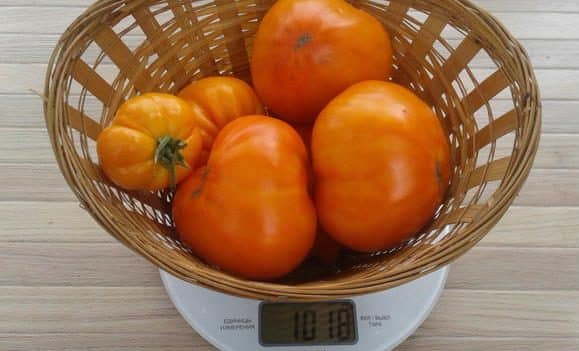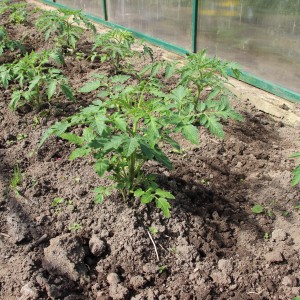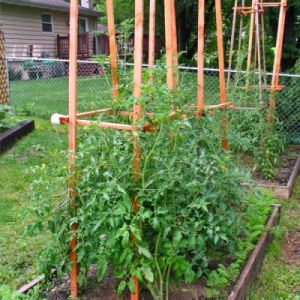The “Honey Giant” tomato is promising and adored by many farmers: characteristics and description of the tomato variety
There are many varieties of tomatoes, but only a few evoke true love and admiration among gardeners. The “Honey Giant” tomato can rightfully be called one of those that cannot leave any garden lover indifferent. It is this that will be discussed in today’s article, which presents the most complete and up-to-date information regarding this amazing variety.
We will talk about growing methods, care features and the main characteristics of the vegetable. Issues of origin, application and resistance to certain diseases will also be addressed.
Description of the variety
The variety can be called relatively new, since it was bred by Russian breeders in 2001 and registered in the State Register in 2003, but during its existence it managed to win the hearts of many gardeners.
The tomato gained its fame thanks to its commercial qualities and for many years has topped the lists of the largest and most remarkable varieties. This variety is standard and indeterminate, since in terms of height it can reach 150 cm.
Distinctive features
The very name of the variety already speaks volumes. Its huge size in relation to other tomatoes arouses such interest and recognition among both amateur gardeners and real collectors of the most attractive varieties.
According to statistics, with proper and constant care, the vegetable can easily grow from 600 grams to 1 kilogram.However, this applies more to real professionals, and in most cases, with average care, the result is a fetus of 350-400 g.
No less attractive is the beautiful bright orange, sometimes yellow color that the tomato turns into when ripe. This coloring brings not only aesthetic pleasure, because yellow varieties of tomatoes have a more enriched vitamin and mineral composition, while yellow tomatoes do not cause allergies. They contribute to the healing and rejuvenation of the body.
Fruit characteristics and yield
If we talk about the fruits, they are large in size and flattened in shape. The skin is thin, bright yellow or orange, and when cut, the tomato will even have pinkish tints. With the right approach, they can be easily stored for a long time and tolerate transportation well, maintaining their aesthetic and taste qualities.
The taste is juicy and sweet, moderately containing liquid and pulp, while being resistant to cracking and having an excellent appearance after ripening. According to official data and evidence from gardeners, they contain up to 6% dry matter. Average number of seeds.
The productivity is quite high. One bush can produce from 5 to 7 kg of tomatoes. They are superior to many varieties in terms of productivity and bring amateurs and professionals up to 15 kg of fruit per 1 sq. m.
How to grow seedlings
The sowing process begins around the beginning of March, but most gardeners rely on the lunar calendar when choosing the right day for sowing. The first rule for starting seed preparation is to read the instructions from the manufacturer, if available.
In most cases, manufacturers do not provide information regarding seed treatment, so you need to start preparing with soaking. For this purpose it is taken manganese solution, in which the seeds are soaked for one hour, after which they are thoroughly washed. It would not be a bad idea to soak them a few days immediately before planting in another solution - aloe with water in a ratio of 1 to 2.
Container and soil
Soil for seedlings can be used either purchased or regular from the garden, which experts recommend mixing with humus and peat in a 1 to 1 ratio. Before planting, you can enrich the soil with special complex preparations with a high content of phosphorus, potassium and nitrogen.
Sowing
Before planting, the soil is watered with boiling water, and the seeds are planted at a depth of 1 cm, after which they are moistened and covered with film. For seedlings to germinate, it must be at a temperature of 26-28 degrees, although after germination it must be reduced to 22 degrees during the day and 18 at night.
Growing and care
When the first shoots appear, the container with the seedlings is moved to the window so that the future tomatoes bask in the sun for 8 hours. If natural light is not enough, then you need to acquire special lamps and illuminate the seedlings for the same period of time.
It is necessary to water in moderation so that the water does not stagnate, spoiling the plant.
Important! The honey giant requires mandatory picking in the phase of 1-2 true leaves.
Two weeks before planting, it is necessary to begin hardening off the plants so that they can better survive the transfer.
Seedlings are planted in the ground 60-65 days after sowing the seeds.
We transplant into the ground and grow the Honey Giant
Before planting, the soil must be checked and prepared. The soil should be loose, so dig it up, simultaneously removing any plant debris and weeds. It is advisable to enrich it with humus and, if necessary, add ash or lime if the soil is loose. After this, the soil is leveled with a rake and approximately how the holes will be located is planned.
 Usually, per 1 sq. m. there are about three bushes, since this variety has a large height and spread of clusters. If the soil is too heavy, then peat or sand is used, but here you need to look at the situation. Directly when planting in a hole, which should be 20 cm deep and at a distance of 60x50 cm from each other, it is advisable to add superphosphate, and after planting, water the plant with warm water.
Usually, per 1 sq. m. there are about three bushes, since this variety has a large height and spread of clusters. If the soil is too heavy, then peat or sand is used, but here you need to look at the situation. Directly when planting in a hole, which should be 20 cm deep and at a distance of 60x50 cm from each other, it is advisable to add superphosphate, and after planting, water the plant with warm water.
A distinctive feature of this variety is its sensitivity to high temperature changes, so seedlings mulch straw, covering it about 10 cm thick.
Supports must be prepared, since the plants are tall.
Care
Experts advise feeding the plants with potassium nitrate after two weeks from the date of transfer, and after another two weeks it is advisable to fertilize the soil with a solution of manure and water in a ratio of 1 to 10. Then it is advisable to look at the situation and alternate these feedings and complex fertilizers to achieve the best result.
Once a week in the evening, it is necessary to remove the stepsons (in the end there should be one left in the upper axil) and the old lower leaves, and after each watering, thoroughly loosen the soil. If the seedlings are located in a greenhouse, they are often ventilated.
Hilling is carried out 10 days after planting, and this is done exclusively after glaze. Repeated hilling occurs after a couple of weeks.This procedure stimulates active plant growth and improves resistance to various diseases and numerous parasites.
When the stem reaches a height of one and a half meters, pinching is required. At the same stage, tying occurs so that the stem does not break under the weight of the fruit and takes the correct shape.
Features of cultivation and possible difficulties
It is necessary to actively monitor the growth of plants, since due to the fairly high stem, it may require not only a garter, but also reliable support. Considering how heavy the fruits are, of which there will be many on one bush, this is a prerequisite, otherwise the stem may break and the plant will die.
 Before positioning the support, disinfect it. When the fruits are already present and begin to actively ripen, remove most of the leaves so that nothing interferes with the tomatoes ripening. Many gardeners water the holes with a manganese solution at this stage to prevent elemental deficiency and improve the plant’s immunity.
Before positioning the support, disinfect it. When the fruits are already present and begin to actively ripen, remove most of the leaves so that nothing interferes with the tomatoes ripening. Many gardeners water the holes with a manganese solution at this stage to prevent elemental deficiency and improve the plant’s immunity.
Root spraying should not be done, as this method is completely unsuitable for this variety. “Honey Giant” is not considered a particularly picky and difficult variety, so even with average care it produces good yields.
It is advisable to leave only 1-2 stems in the bush.
Diseases and pests
The tomato is quite easy to care for and, in principle, is not susceptible to fungal diseases. The only thing that can cause trouble is poor care. It is important to follow the watering regime, feed the plant, thoroughly loosen the soil and actively fight various weeds.
If we talk about parasites, then this variety of tomatoes, like most others, is susceptible to such scourges as thrips, whiteflies, mole crickets, slugs, Colorado potato beetles and melon aphids. If such unpleasant situations happen, then you should use such remedies as “Bison” for thrips and “Confidor” for whiteflies, although folk remedies can also help.
For example, a solution of one spoon of pepper and a bucket of water will help solve the problem with aphids, slugs and mole crickets, or replace the pepper with mustard powder. It is important to use these products for both spraying and watering to achieve the best results.
Keep in mind that all pest control agents accumulate in the fruits, so they are applied before flowering.
The nuances of growing in open ground and in a greenhouse
Growing and care in a greenhouse and open ground differs only in a few points described. In a greenhouse, the main thing is to monitor ventilation and humidity, since if not properly cared for, there is a high chance that the plant will be susceptible to fungal diseases and parasites.
It is important to plant the seedlings correctly at the correct distance from each other so that the plants have the freedom to grow without interference. Supports are placed in any case, because with tall plants there is no other way to achieve high yields and tasty fruits.
In open ground, you need to correctly calculate the day when to plant the plant. It is important to insulate the soil for seedlings after planting with a layer of straw approximately 15 cm thick.
Harvesting and application
According to their taste characteristics, the fruits are most suitable for fresh consumption. In particular, they complement various salads seasoned with oil or special dressing.
The fruits are too large for preservation and it is unlikely that they can be placed in jars as a whole, so winter salads or something like stews are made from them. Thanks to their attractive color, tomatoes are a great addition to any dish.
As for juices and pastes, Honey Giant is not used for this.
Advantages and disadvantages
Characteristics of the variety allow you to quickly assess the advantages and disadvantages. If we talk about the advantages, then these include high taste, excellent yield, health benefits when eating tomatoes, disease resistance and the ability to grow tomatoes for sale.
Of course, the variety also has disadvantages. This is a step-by-step care, which for some may seem quite complicated, the need for constant feeding, picking, gartering, bush formation and the inability to use in some types of conservation.
Farmer reviews
Farmers speak positively about this variety, because it can be stored for a long time, does not crack when ripe, can easily be transported and captivates with its appearance and taste.
Conclusion
The tomato is mid-season, suitable for growing in various types of soil and under different weather conditions, if you use a greenhouse. It gives a high yield, the fruits are large and fleshy, and do not crack. You should not be afraid of certain difficulties in care, because the “Honey Giant” generously rewards its owners with beautiful, juicy and incredibly tasty fruits.